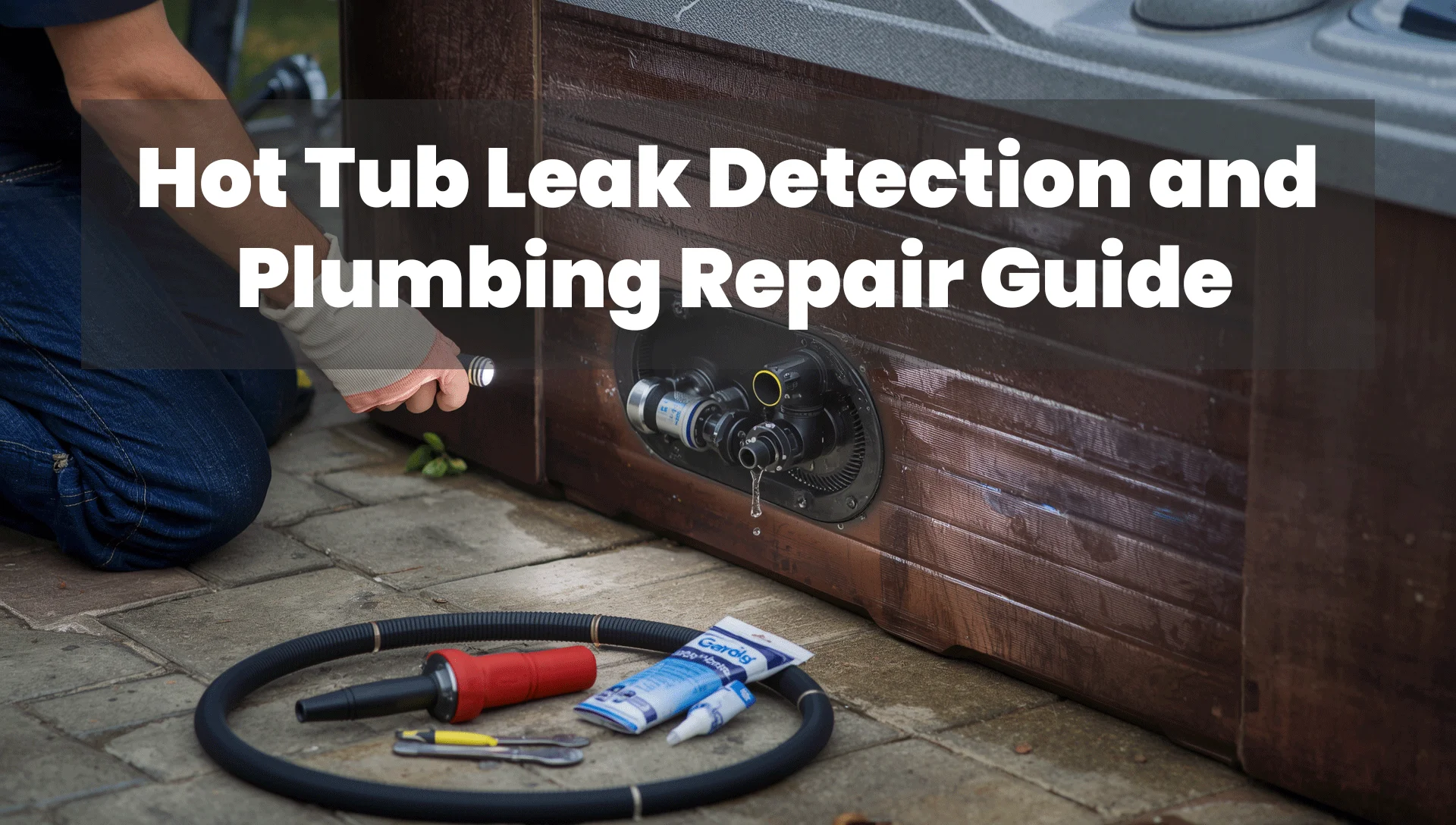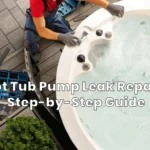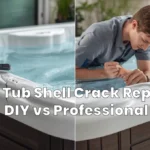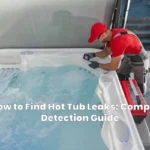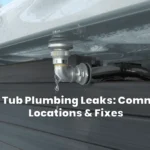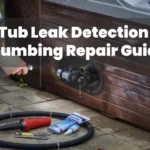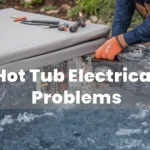Hot tub leaks are a silent killer that will silently eat away at your components and increase your water and electricity bills. It can be a hairline crack, an unseen plumbing problem, or a hot tub pump that has sprung a leak; early leak detection can save time and money.
This guide will take you through the steps of locating a leak in a hot tub, the common causes, DIY versus professional repairs, and strategies for preventing leaks in the long term. By the end, you will be able to understand how to preserve your investment and also how to make your spa last longer.
Why Leaks are a Serious Hot Tub Problem
A minor leak may not seem harmless initially, but in a hot tub leak, even a drop over a drop can cause bigger problems in the long run.
- Structural Damage—The water will seep into the base or the cabinet and cause rot and mold or weaken the framing.
- Corrosion of Equipment—Pumps, heaters, and electrical equipment are susceptible to corrosion by water.
- Expensive Utility Bills—Constant water leakage causes your pump and heater to work more, increasing your electricity bills.
- Water Chemistry Imbalance—The sanitizers will require frequent refills as water is constantly added, diluting the sanitizers.
- Increasing Repairs—Minor leaks tend to spread and can turn into expensive repairs when ignored.
Shortly put: when leaking begins, it is seldom stopped by itself. An immediate response to it prevents additional damage.
Clues to Increased Water Flow: Your Hot Tub Could Be Leaking
An early detection of leaks can save hundreds of dollars in repair expenses. Be alert to the following warning signs:
- Unexplained loss of water—water level falls beyond the normal level of evaporation
- Wet Areas Underneath – Puddles or wet ground around the spa cabinet
- Soggy Insulation—The red flag in the cabinet is a soaking form.
- Low Water Pressure—Lack of water pressure can be an indication of leaks in the plumbing
- Pump Cycles Less Frequently—A leaking system causes the pump to cycle more than is necessary.
In case you observe an occurrence of any of them, you should act.
STEP 1: Locating a Leak in a Hot Tub
The most difficult part of hot tub leak repair is locating the leak. These steps are to be followed:
- Cut power—Make sure to switch off power to the spa.
- Remove side panels—open up the equipment area to a better view.
- Look at Visible Drips—Pumps, Unions, and Connections.
- Check Water Pooling—Water tracks may show a leakage path.
- Leak detection dye is to be used—add dye to the water and trace where it leaks.
- Pump Test—Any loss of water when the pump is switched off is on the pressure-side plumbing.
Typical Leak Points
Leaks are typically in a few common areas:
- Pump Seals and Unions—O-Rings are used up by heat and vibration.
- Heater Connections—Conductors coming loose or corroded parts
- Jets—cracked jet bodies or degraded gaskets
- Plumbing Lines—Freeze damage or wear and tear due to vibration.
- Hot Tub Shell—Stress fractures or inadvertent impact damage
- Pro Tip: Look at visible equipment and plumbing that is not visible.
Read More: How to Find Hot Tub Leaks: The Ultimate Guide
Step 2: How to Repair Hot Tub Leak Yourself or Professionally
After locating the leak, determine whether you need to fix it on your own or you need to bring in professional help.
Do-it-yourself Hot Tub Leak Repair
Best in minor and visible problems:
- Loose fitting or unions
- Leaking small jet gaskets
- Slight breaks in PVC plumbing.
Equipment & Supplies you might Require
- Variable adjustable wrench & screwdriver set
- Teflon tape to seal threads.
- New Orleans or gaskets.
- PVC pipe repair kit (primer + cement).
- Minor cracks in sealant or epoxy.
The repair cost is inexpensive and can be done DIY, usually costing between 20 and 100 dollars in materials.
Professional Hot Tub Repair Leak
Call a specialist in case.
- The leak is concealed in foam insulation
- The plumbing conduits beneath the shell have been broken
- Electrical parts are used in it
- You cannot detect the leak when you inspect it.
Professional repair costs are between $200 and $1000, depending on the seriousness. Although they are more costly, they are certain to repair the leak completely.
Related Reading: Hot Tub Shell Crack Repair: Do it Yourself vs. Professional
Step 3: Fixing the Leaks of Various Types
Hot tubs may start to leak in various ways. Here are the ways of how to repair each type:
Hot Tub Leaking Plumbing
PVC fittings and pipes account for most of the spa plumbing leaks.
Fixes:
- Drain the spa
- Cut out the damaged part of the PVC pipe using a PVC cutter.
- Clean the area dry.
- Use PVC primer and cement to replace fittings.
- Leave to dry and refill.
Hot Tub Pump Leaking
When you see water around the pump, it is usually the case of a failed seal or union.
Fixes:
- Disconnect power and empty the spa.
- Remove pump unions with care
- Replace the bad O-ring or mechanical seal.
- Reinstall the pump and check it for leakages.
How to DIY Hot Tub Crack Repair
Cracks are one of the most frequent problems in shells but they are manageable
How to Repair Small Cracks:
- Dry the cracked area.
- Sand lightly to provide adhesion.
- Use epoxy or fiberglass filler
- Allow to dry thoroughly and fill again
Cracks or damages that are large need a professional assistance
Similar Reading: Where Do Hot Tub Plumbing Leaks Occur: Solutions
Step 4: Averting Future Leaks
The best long-term solution is prevention.
- Water Chemistry—Unbalanced pH can destroy seals and gaskets.
- Monitor Plumbing on a Regular Basis—Check unions, jets, and heater connections every 3-4 months.
- Avoid Overtightening—A lot of force will weaken unions in the long term.
- Winterize Your Spa—Prevent freeze damage by draining or keeping water moving
- Plan Regular Maintenance—an expert review improves service life
Superior Locating Techniques
In case there is a particularly hard-to-detect leak, specialists have special equipment:
- Pressure Testing—Seals any leaks in plumbing lines.
- Acoustic Listening Devices—Hear the sound of escaping water
- Thermal Imaging Cameras—Detect wet insulation spaces that are concealed in foam
Such techniques are time-saving and avoid unwarranted dismantling.
Stopgap Repairs Until Total Repair
Sometimes a short-term fix is what you need to keep your spa operational as you wait to fix them.
- Hot tub leak sealant—seals small internal leaks
- Seal the leaking jet nozzle—holds the water until the nozzle is replaced
- Lower Water Level—Maintain water below leaking point
These are only short-term solutions—they should be followed up with a lasting repair.
Related Reading: How to Fix a Hot Tub Pump Leak: Step-by-Step Guide
FAQs
Can I use my hot tub when it is leaking?
Not recommended. Running it can aggravate damage and can cause problems with electricity.
What is the hot tub leak repair cost?
DIY: $20–$100
Professional: $200-$1000+, depending on the severity.
What is the time duration of repair?
Quick repairs: 1-2 hours.
Major repair: A day or more.
How long does hot tub plumbing last?
With good maintenance, 10-15 years.
Do Spa Leak Sealants Permanently Seal a Spa?
They at times work but are only short-term solutions
What Can I Do to Prevent Freeze Damage?
Winterize your spa or have the circulation pump running during freezing weather.
Are All Leaks Hot Tub Draining Required?
Most of them, but some jet gasket replacements can be performed with water still inside.
Is DIY Crack Repair Trustworthy?
Small cracks can be solved by yourself, but large or structural cracks would need professional help.
Conclusion
Leaks in your hot tub are more of a problem than a convenience. Timely and proper repair can prevent expensive damage, save you on utility billing, and extend the life of your spa.
Regardless of whether you do a minor repair yourself or hire a specialist to fix difficult damages, the most important thing is to detect and repair them quickly. Maintain the balance of your water chemistry, inspect your spa on a regular basis, and winterize it to prevent future problems.

